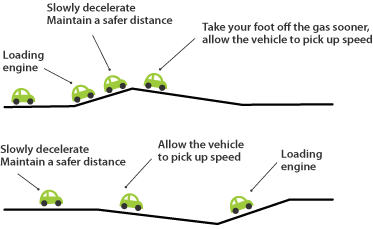Gravity force

The gravity force has a direct impact on your vehicle when you go up or down a slope. It holds you back when you drive up and moves you forward when you drive down. As with the acceleration force, much of the energy consumed going up can be recovered on the way down, allowing you to drive a certain distance without consuming fuel.
The main factors influencing the gravity force are:
The main factors influencing the gravity force are:
| The incline of the slope |
The steeper the incline, the higher the gravity force will be. For example, it is much more difficult to cycle up a steep slope than a gradual slope.
| The vehicle mass |
This mass depends on the type of vehicle and the load carried. It is directly proportional to the gravity force.
| How to reduce the gravity force? |
1
Optimize the engine efficiency when going up a slope
When going up a slope, the engine must be in low speed and high torque mode. This will allow your vehicle to go up the slope with a loaded engine throughout your ascent.
2
Recover the energy when going down the slope
While following the speed limit, you can take advantage of descents by using them as free propulsion. Simply allow your vehicle to progressively slow down and increase the distance between you and the driver ahead of you as you approach a descending slope to save fuel. As you go down, you can recover your initial speed without accelerating.
|
 |
3
Choose a smaller vehicle
Selecting a vehicle that meets your true needs allows you to reduce the mass of your vehicle and your fuel consumption.
4
Eliminate unnecessary weight
Removing unnecessary items from your trunk or storage rack will reduce the total mass of your vehicle and your fuel consumption.











